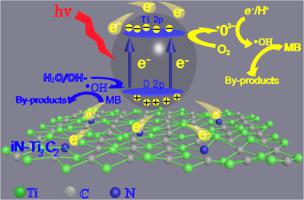Journal of Hazardous Materials ( IF 12.2 ) Pub Date : 2020-09-22 , DOI: 10.1016/j.jhazmat.2020.124066 Tao Ke , Shuyi Shen , Krishnamoorthy Rajavel , Kun Yang , Daohui Lin

|
Construction of heterojunction and nitrogen doping is an effective approach for synthesizing photocatalysts with high quantum yield and efficient electron-hole separation. 2D MXene Ti3C2 has been considered a good carbonaceous nanomaterial for designing heterojunction, while the original surface groups and stacked structure limit the electron-hole separation. Herein, a hybrid of nitrogen-doped Ti3C2 nanosheets and TiO2 nanoparticles (NPs) composed of TiO2 NPs in situ growing on isopropyl amine (iPA) modified Ti3C2 (iN-Ti3C2) was developed for the first time. The novel iN-Ti3C2/TiO2 hybrid exhibited an excellent ultraviolet-light photodegradation of methylene blue (MB), with a degradation rate (0.02642 min−1) significantly higher than that of pure TiO2 NPs, bulk-Ti3C2/TiO2, dimethyl sulfoxide modified Ti3C2/TiO2 hybrid, and hydrazine monohydrate modified Ti3C2/TiO2 hybrid. The formation of heterojunction between iN-Ti3C2 and TiO2 and its role in the photocatalysis were systematically analyzed using various characterization techniques and density functional theory calculation. The iPA modification exfoliated Ti3C2 and doped N on Ti3C2 nanosheets; the in situ grown TiO2 NPs formed efficient heterojunctions with the nanosheets; the N-doping facilitated electron migration in Ti3C2 and inhibited the recombination of photogenerated electron-hole pairs; •OH dominated the photodegradation of MB. This work provides a new approach of constructing efficient photocatalysts for the treatment of organics-polluted water.
中文翻译:

TiO 2纳米粒子在氮掺杂的Ti 3 C 2上用异丙胺原位生长,以增强光催化活性
异质结和氮掺杂的构建是合成具有高量子产率和有效电子-空穴分离的光催化剂的有效方法。2D MXene Ti 3 C 2被认为是设计异质结的良好碳质纳米材料,而原始的表面基团和堆叠结构限制了电子-空穴的分离。这里,氮掺杂的钛的混合3 c ^ 2纳米片和TiO 2个的TiO构成的纳米颗粒(NP)2周的NP在原位上异丙胺(IPA)生长改性的Ti 3 Ç 2(在钛3 Ç 2)是第一次开发。新型iN-Ti 3 C 2 / TiO 2杂化物表现出优异的亚甲基蓝(MB)紫外光降解性能,其降解速率(0.02642 min -1)明显高于纯TiO 2 NPs体-Ti 3 C 2 / TiO 2,二甲亚砜改性的Ti 3 C 2 / TiO 2杂化物和一水合肼改性的Ti 3 C 2 / TiO 2杂化物。iN-Ti 3 C 2与TiO 2之间异质结的形成使用各种表征技术和密度泛函理论计算系统地分析了其在光催化中的作用。iPA修饰在Ti 3 C 2纳米片上剥落了Ti 3 C 2并掺杂了N。在原位生长的TiO 2个纳米颗粒形成为与纳米片高效异质结; N掺杂促进了电子在Ti 3 C 2中的迁移,并抑制了光生电子-空穴对的复合。•OH主导了MB的光降解。这项工作提供了一种构建有效的光催化剂来处理有机物污染水的新方法。











































 京公网安备 11010802027423号
京公网安备 11010802027423号